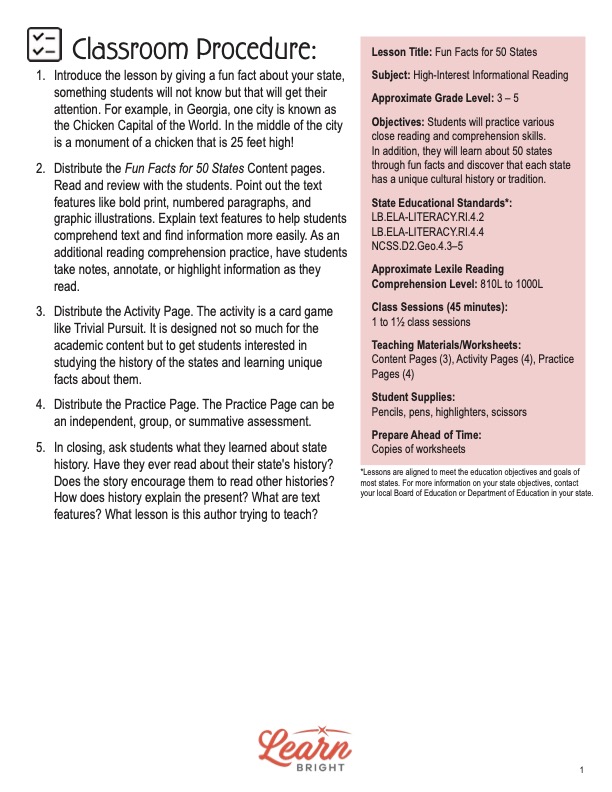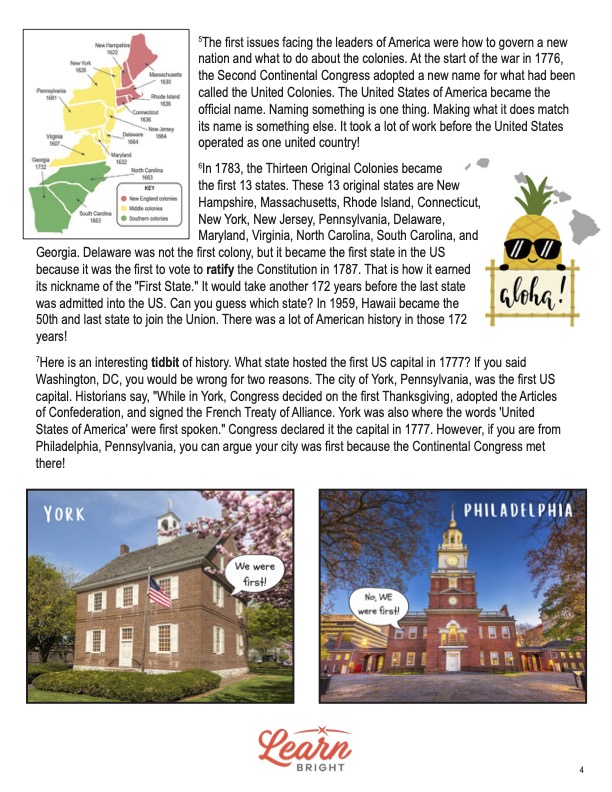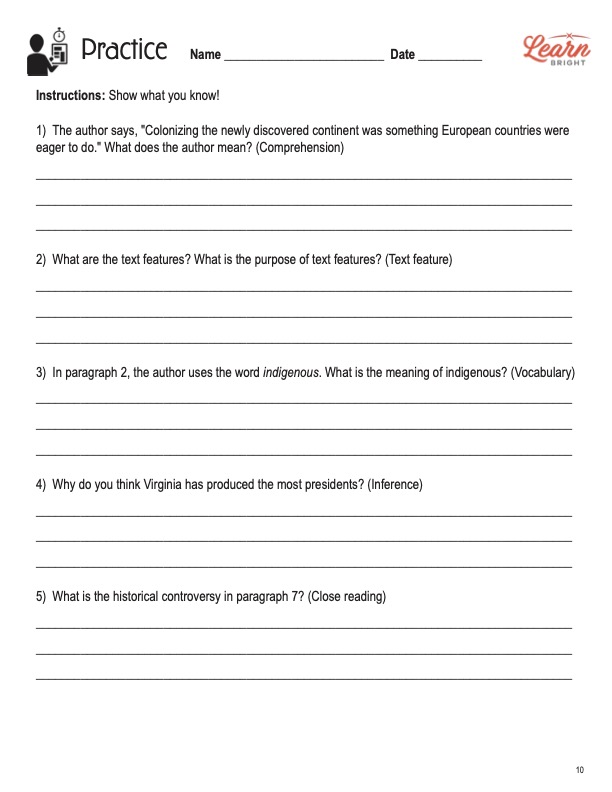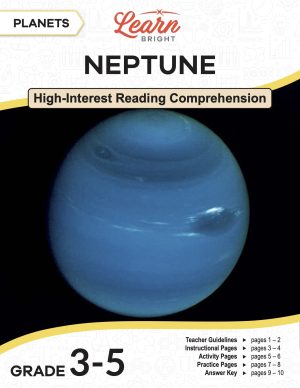Description
What our Fun Facts for 50 States lesson plan includes
Lesson Objectives and Overview: Fun Facts for 50 States is a high-interest reading comprehension lesson plan. As such, students will practice various close reading and comprehension skills. In addition, they will learn about the 50 states through fun facts and discover that each state has a unique cultural history or tradition. This lesson is for students in 3rd grade, 4th grade, and 5th grade.
Classroom Procedure
Every lesson plan provides you with a classroom procedure page that outlines a step-by-step guide to follow. You do not have to follow the guide exactly. The guide helps you organize the lesson and details when to hand out worksheets. It also lists information in the yellow box that you might find useful. You will find the lesson objectives, state standards, and number of class sessions the lesson should take to complete in this area. In addition, it describes the supplies you will need as well as what and how you need to prepare beforehand. In addition to pens, pencils, and highlighters, make sure your students have scissors for the activity portion of the lesson.
Teacher Notes
The paragraph on this page provides a little more information or guidance on what to expect from the lesson. It explains that you can teach this lesson in a whole-class setting or as an independent, small-group activity. You can use the blank lines to record any thoughts or ideas you have as you prepare.
FUN FACTS FOR 50 STATES LESSON PLAN CONTENT PAGES
A Brief History
The Fun Facts for 50 States lesson plan contains three content pages. You probably know a lot about the state where you live. Whether you live on the East or West Coast or in the middle, northern, or southern United States, there are a lot of exciting and fun facts about each state. Have you ever traveled to a different state? Perhaps you were on vacation, visiting a friend or relative, or going to see an attraction or landmark. Every state has something different and unique!
You probably learned from your history lessons that the United States wasn’t always the United States. It started off as colonies of countries like Great Britain. Even before there were colonies, indigenous people roamed across the American continent. The first explorers had no way of knowing how large the land mass was. They had discovered a continent with natural resources that were valuable to their home countries. Colonizing the newly discovered continent was something European countries were eager to do.
From the time of the earliest explorers, colonization occurred rapidly. Nearly every European country wanted to establish colonies, build military outposts, and claim land ownership in America. Great Britain, France, and Spain were the major forces in the early expansion of settling America. Eventually, Great Britain and France went to war in 1754, and Great Britain emerged victorious by 1763. Britain gained all French territory east of the Mississippi River.
Revolutionary War and the Start of the States
The British victory was short-lived, though. War on the American and European continents drained Great Britain of financial resources. The British began imposing fees and taxes on the American colonies to recoup some of the expense of managing the American colonies and debts from the wars with France. You know what happens next! The Americans were not keen on paying Great Britain what they felt were unreasonable sums of money. This and other issues led to the American Revolutionary War. When the war ended in 1783, America declared independence from British rule.
The first issues facing the leaders of America were how to govern a new nation and what to do about the colonies. At the start of the war in 1776, the Second Continental Congress adopted a new name for what had been called the United Colonies. The United States of America became the official name. Naming something is one thing. Making what it does match its name is something else. It took a lot of work before the United States operated as one united country!
In 1783, the Thirteen Original Colonies became the first 13 states. These 13 original states are New Hampshire, Massachusetts, Rhode Island, Connecticut, New York, New Jersey, Pennsylvania, Delaware, Maryland, Virginia, North Carolina, South Carolina, and Georgia. Delaware was not the first colony, but it became the first state in the US because it was the first to vote to ratify the Constitution in 1787. That is how it earned its nickname of the “First State.” It would take another 172 years before the last state was admitted into the US. Can you guess which state? In 1959, Hawaii became the 50th and last state to join the Union. There was a lot of American history in those 172 years!
Where Is the Capital?
Here is an interesting tidbit of history. What state hosted the first US capital in 1777? If you said Washington, DC, you would be wrong for two reasons. The city of York, Pennsylvania, was the first US capital. Historians say, “While in York, Congress decided on the first Thanksgiving, adopted the Articles of Confederation, and signed the French Treaty of Alliance. York was also where the words ‘United States of America’ were first spoken.” Congress declared it the capital in 1777. However, if you are from Philadelphia, Pennsylvania, you can argue your city was first because the Continental Congress met there!
How many states in US history have been home to the national capital? Would it surprise you to learn that cities in four states have been the capital? They are New York (New York City), Pennsylvania (Philadelphia, Lancaster, and York), Maryland (Baltimore and Annapolis), and New Jersey (Princeton and Trenton). The District of Columbia (DC) is a Constitutional federal district encompassing the current US capital, Washington. It is entirely outside all of the states and is its own entity. On a map, it looks like it’s part of Maryland.
From Presidents to Peanuts
You know who the first president of the United States was—George Washington. George Washington was born in Virginia, but he wasn’t a US citizen. (There was no USA at the time!) So who was the first American citizen to become president of the United States? Martin Van Buren, the eighth president, was the first natural-born American citizen to become president. Until Van Buren’s presidency, all the others were born under British colonial rule and were British subjects. Van Buren was born in New York in 1782, six years after the signing of the Declaration of Independence.
Which state has produced the most presidents? Here is a hint: It was one of the original colonies. If you said Virginia, you are correct! Eight presidents were born in Virginia. Four of the first five were Virginians. Although most states can’t brag about being the birthplace of a president, every state has something unique and interesting to offer.
Some have cool nicknames, like the Buckeye State or the Peach State. The Buckeye State nickname comes from Ohio, which has so many Buckeye trees. The Peach State is Georgia. Georgia got this nickname because commercial peach production began there. Oddly enough, however, more peaches are grown in South Carolina than in Georgia! (South Carolina is the Palmetto State.) Georgia grows about 45% of all the peanuts in the United States, though. But perhaps they didn’t want to be known as the “Nut” State!
What about the state you live in? Does it have a fascinating history or nickname? Studying your state’s or others’ history doesn’t have to be boring. Every state has lots of interesting places, attractions, and stories. Studying the history of the states can be enlightening, and it’s fun to learn offbeat facts about where you live!
FUN FACTS FOR 50 STATES LESSON PLAN WORKSHEETS
The Fun Facts for 50 States lesson plan includes two worksheets: an activity worksheet and a practice worksheet. Each one will help students solidify their grasp of the material they learned throughout the lesson. You can refer to the classroom procedure guidelines to know when to hand out each worksheet.
TRIVIAL PURSUIT STATES EDITION ACTIVITY WORKSHEET
Students will get to test their trivia knowledge during the activity. They will cut out all the fact cards and play a game of Trivial Pursuit. You can divide students into partners or groups for the game. Students will take turns drawing cards from their pile and answers the questions. Each correct answer earns a point. Once all the cards have been drawn, the student with the most points wins.
FUN FACTS FOR 50 STATES PRACTICE WORKSHEET
The practice worksheet requires students to answer a series of 10 questions. These questions all relate to the content pages, so students will need to refer to them often for the answers. In addition, each question provides which reading tool the question corresponds to, such as text feature, vocabulary, or comprehension.
Worksheet Answer Keys
At the end of the lesson plan document is an answer key for the practice worksheet. The correct answers are all in red to make it easier for you to compare them with students’ responses. If you choose to administer the lesson pages to your students via PDF, you will need to save a new file that omits these pages. Otherwise, you can simply print out the applicable pages and keep these as reference for yourself when grading assignments.









